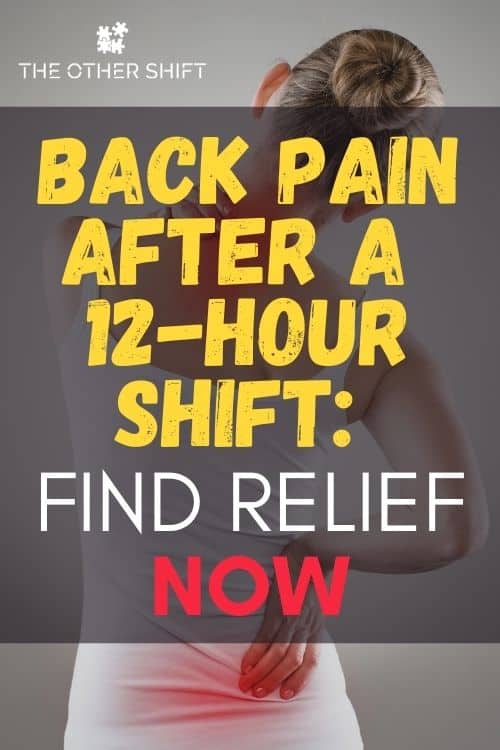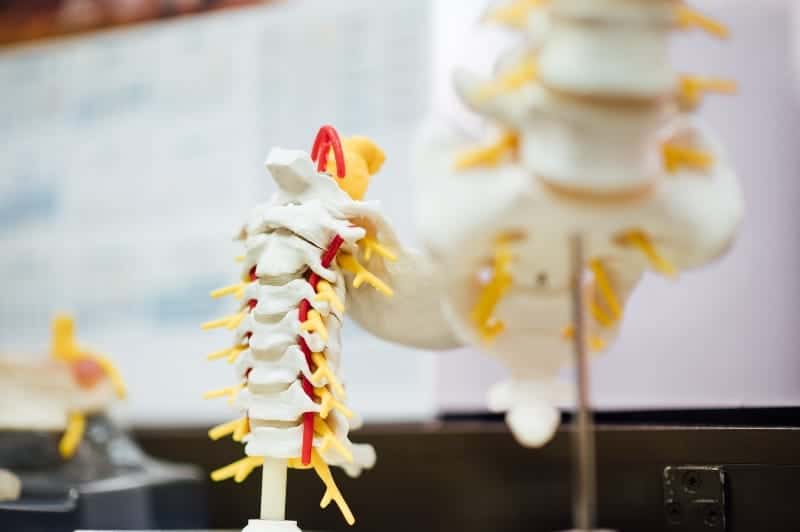Disclosure: This page may contain affiliate links, meaning we receive a commission if you decide to make a purchase through our links, but this is at no additional cost to you. Please read our disclosure and privacy statement for more info.
Shift work has the potential to cause some severe health problems, especially when working a physically demanding job you have little control over. One of the largest complaints among shift workers who undertake a 12-hour shift is debilitating back pain. But why does it come about so frequently?
Back pain over a 12-hour shift is often caused by lifting objects incorrectly, poor posture and standing in one position for an extended period. To help decrease likely back pain, wear the right shoes, stretch before/throughout/after your shift, see a physical therapist, and invest in a Shakti Mat.

As we continue in this article, we’re going to look at some of the leading causes of back pain in shift workers, especially those who work 12-hour shifts. In addition, we will share some very simple, easy measures you can take to greatly decrease the pain in your back and lower the chances of suffering back pain altogether.
Health Effects From Standing for an Extended Period of Time
One thing you might have noticed when being on shift is that standing in the same spot for multiple hours at a time can have a major effect on your body’s health. This can go beyond even back pain.
In fact, many studies have shown standing in a single position, without walking or sitting, for extended periods of time can cause other health issues such as varicose veins, muscular fatigue and cardiovascular disease, in addition to general back pain and neck stiffness.
Ironically enough, many of these issues are caused simply by the amount of effort from your muscles required to actually standstill, especially the muscles in your back, neck and legs.
Standing inhibits blood flow to the muscles which results in muscle fatigue. Though we don’t realize it, standing in the same spot for hours is effectively the same as constantly walking for that same period. When you add to that heavy lifting or, in turn, constant bending, the fatigue on your muscles is increased causing a great deal of pain.
Related: How to Relieve Foot and Leg Pain from Standing All Day

Short-term pains such as cramps and aches are associated with standing for an extended period. This is due to the body not liking holding the same position over a long period. It’s likened to a machine having to hold up a load for an extended period; this often leads to the machine breaking down at an accelerated rate. The same is true for your body.
When you’re standing still for a long time, your muscles, mainly your back, are having to hold the same position and be strained while you’re in that position, often with less blood flow. That’s why moving and changing positions is often referred to as “getting the blood moving”; that is essentially what you are doing when you change positions or walk for a few minutes at a time.
Additionally, standing for an extended period has a large impact on your back’s skeletal system.
Over time, the discs in your back which cushion the vertebrae will degenerate causing the vertebrae to rub together. If this is happening in you you’ll notice a dull, achy pain across the beltline of your lower back.
Another effect on your back’s bones is when the soft tissues in your back are strained, the spine will often lose alignment. This will cause a sharp pain to shoot down your back and, as the period of time you are standing increases, so does the strain on these tissues, which causes them to break down even more.

When to See Your Doctor For Persistant Back Pain
Regrettably, back pain is considered to be a “hazard of the job” by many, leading most shift workers to ‘solider on’ through the pain day after day. Unfortunately, this causes the pain to increase, which is a tall tale sign the condition causing the pain is getting worse. But when should you get your back pain checked out?
If your back pain becomes constant, it’s time to get it checked out.
You should also investigate further if you notice the pain increases when you lie down or if it starts to spread down your leg. Other symptoms which should prompt you to see a doctor include:
- Unexplained and drastic weight loss
- Weakness or numbness in your extremities, such as your legs and arms
- Swelling or redness across your back
- Pain which becomes unbearable
Related: Why Does My Body Ache After Night Shift?
Remedies for General Back Soreness When Working 12-Hour Shifts
If your back pain is more of a nuisance than a pain, or if you want to prevent back pain in the first place, there are some basic steps you can take which will do wonders for your back. In this section of the article we’re going look at a few.
Get the right shoes
Not all shoes are created equal and just because the shoes are comfortable when trying them on in the store, this doesn’t mean they are right for being on your feet for several hours at a time.
What many shift workers have noticed is shoes with hard leather soles actually have more support for extended standing than sneakers do; sneakers tend to squish quickly, which leads to improper posture, insufficient support and back pain.
Also, rotating shoes is a common practice among shift workers. We don’t often think about this but shoes often need 24 hours to recover from being excessively worn, so having two or more pairs is best.
HOKA shoes for example are durable and reasonably priced and are often spoken about within our community.
Stretch before and after your shift
Now don’t laugh, but stretching and light exercises before and after your shift will help your muscles to decompress and release, allowing for quicker recovery. In turn, the tension in the muscles which support your spine is reduced, not to mention the improved range of motion and flexibility which is developed over time through stretching.
When stretching, be sure to wear loose clothing which won’t bind or restrict your movements. When going into a stretch, do so slowly and hold the stretch for 15 to 30 seconds; long enough to truly stretch the muscles out.
Remember it takes about 4 repetitions of a stretch for the muscle to reach full elongation.
Here are a few stretches you can try to prevent or alleviate back and neck pain:
- Corner Stretch – While facing the corner of a room, place your forearms on each side with your elbows at shoulder height and lean forward. This will stretch the muscles under your collarbone.
- Knee to Chest – Start of by laying on your back with both knees bent and feet planted on the floor. Then, one at a time, place both hands behind your knee and pull it to your chest and hold it there. Do this several times with each knee, alternating back and forth.
- Lunge – While kneeling with both knees on the floor, move one leg forward with the foot planted on the ground. Then, being sure to stay balanced, place both of your hands on the thigh of the extended leg and lean your body forward.
If you want more stretches, take a look at the video below from Dr. Jo for inspiration.
Physical Therapy
Having a physical therapy routine can actually do wonders for decreasing back pain. Often, you will have to be referred to a physical therapist by your primary care doctor. Also, doctors are likely to recommend seeing a physical therapist for back pain that has lasted longer than two weeks or if you have frequent reoccurrences of the same type of back pain.
Some might also recommend seeing a chiropractor who specializes in back pain corrections.
When going to a physical therapist, they will likely use a treatment that includes alternating heat and ice packs for a period of 20 minutes each. This will help reduce any swelling of your muscles and joints and aid in muscle recovery.
These microwavable heat packs on Amazon are pretty popular if you’re in need of one.
They are also likely to use what is called a Tens machine. Simply put, a tens machine sends small electrical impulses to the area you’re having pain in an effort to reduce the pain signals being sent to your brain. This helps to not only relieve your pain and relax your muscles but also promotes the releasing of your body’s painkiller called endorphins.
If health insurance is a problem or you’d like to try a tens machine yourself, this one pictured below is great. The feedback is impressive and it comes with everything you need to get started to finally relieve your backaches and pains.

Use a Shakti Mat
Known as the modern-day bed of nails, though not as dramatic as that might seem, the Shakti Mat uses over 6000 tiny points to help stimulate blood flow and the releasing of endorphins. It uses an ancient healing practice known as acupressure, similar to acupuncture without the puncturing part. Instead, this mat literally pokes you where you’re hurting to cause more blood to flow to the hurting area.
Though you wouldn’t know it by looking at it, the Shakti Mat helps you to relax, which is the main source of back pain in shift workers. This relaxation can help with all types of neck and back pain, as well as sore feet, general fatigue and even insomnia.

Other Back Pain Relieving Products;
- Inversion table. This devices may look wild but it’s very effective for a lot of users.
- Back Stretcher
The ultimate back roller - Back Pain Relief Gel Pack
- Back brace support belt for your lumbar spine
In this post, we mention the Shakti mat along with 24 other items believe make working the night shift that smidge easier. I’d love to hear what you think of my list and what other items you’d include. Click here and let me know in the comments.
Strategies to Relieve Back Pain During Your 12-Hour Shift
As we’ve been discussing throughout the article, the majority of back pain in shift workers stems from standing in one position for extended periods of time. This can be standing behind the counter at a bank or retail location or working at an assembly line in a manufacturing facility.
Regardless of what type of work you are in, there are some steps you can take on the job to give your body a rest.
Take a break or change positions
Take a break from standing in the same position periodically, at least every 30 minutes to an hour. This can be as simple as stepping away from the counter and moving your body in different directions to get the blood pumping. This could also take the form of small stretches while at the workstation.
If possible, sitting down for a couple of minutes will also help give your body some relaxation during the shift.
If you do need to stand for extended periods, can you discuss with your manager the possibility of getting mats to cushion your feet and back? A floor mat like this one will do the trick.
Check your posture throughout your shift
As you work and tire your body, your posture is often the first thing to go, which often leads to even more pain. It takes training your body to remain in the proper posture, either through mentally being aware of how you’re standing or wearing a posture-correcting device while working.
Ask a colleague to be on the lookout for poor posture throughout the shift. But if you work remotely, setting a “reminder to stand straight alarm” is not a bad idea either.
Work at the proper height
Another way to help improve your body’s ability to endure your shift with little to no pain is to be sure your workstation is at the proper height and distance for you. Often we are left with working at stations not designed for us and we stay quiet. However, even a stationary workstation can be customized using something simple like this standing desk converter on Amazon.
For example, if you’re too short for your station, get a solid platform to stand on to not have to reach outside of your normal range of motion.
Wear a Back Brace
If you have little control over the environment and timing of your breaks whilst on shift, wearing a back brace to support the spine and serve as a constant reminder to slow down and bend your knees whilst working might be an effective strategy.
A simple velcro brace like this one might work well.
Stay hydrated
Lastly, we often fail to stay properly hydrated when working our 12-hour shifts. When your body first gets dehydrated, it begins pulling fluids from your muscles and that causes them to deteriorate faster.
Also, early stages of dehydration include a drastic decrease of blood flow, which also causes your muscles to fatigue faster. Staying properly hydrated will help your muscles function at the most optimum levels.
From a hydration perspective, we love the BEAST Tumbler but we also drink SuperGreen TONIK every single morning. If you’re looking for a healthy, energetic start to your day, this is it. If you’d like to learn more, watch my review below.
If you also find your legs are starting to ache at work, compression socks are worth a shot. They made a huge improvement for me and stopped the swelling in my ankles after a long shift at the hospital. If you’d like to read more about compression socks, check this post out.
What solutions can you suggest to your employer?
Most, if not all, employers want their employees to be able to work with minimal impact on their body; they know happy and safe workers are productive. That being said, your employer should have a method already established to field recommendations from you.
If you have a solution you feel would prevent or minimize the effect of your job on your body, you should definitely take it to the appropriate person.
This may be as simple as suggesting it to the supervisor over you. On the other hand, if you are in a position of leadership, whether that be a version of a floor supervisor or in upper management, make it a priority to implement practices which promote healthy workers by limiting the amount of time your employees spend standing in the same position.
Keep Reading;
- Tactful Tips for Pregnant and Postpartum Night Shift Nurses
- 8 Clever Work Scheduling Software & Apps For Your Business
- How Do 24-Hour Shifts Work? When to Sleep, Eat and Recover
Summary
Whatever the cause may be, back pain is one of the most debilitating pains we face and shift workers know it all too well. Taking just a few steps towards a healthier working environment can help to greatly decrease the effects of your job on your body, in turn lowering the amount of pain you deal with both on and off the job.
A welcomed headspace for anyone who’s currently feeling sore!
Cheers,

Disclosure: This page may contain affiliate links, meaning we receive a commission if you decide to make a purchase through our links, but this is at no additional cost to you. Please read our disclosure and privacy statement for more info.
Disclosure: This page may contain affiliate links, meaning we receive a commission if you decide to make a purchase through our links, but this is at no additional cost to you. Please read our disclosure and privacy statement for more info.
Recent Posts
An examination of the night shift professions, that while sometimes underappreciated, are necessary for civilization, in its current form, to exist. A city can be thought of as a machine. Each...
Culminated from an exhaustive yet well-funded journey into the night, this article will prepare you for life outside of work while being a denizen of the dark. During days off, night shift...

